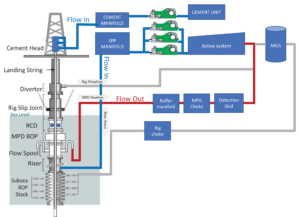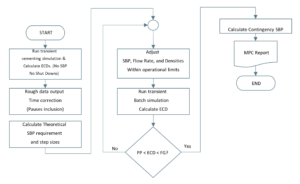Shell successes pave path for MPC in complex deepwater Gulf of Mexico
Case study: Managed pressure cementing helps operator to cement production casing strings using statically underbalanced mud in narrow operating window
By Linda Hsieh, Editor & Publisher; and Sarah Junek, Associate Editor
In May 2018, Weatherford International completed two cementing operations for Shell that paved the path for managed pressure cementing (MPC) in the Gulf of Mexico’s complex deepwater environment. The production casing strings in these two GOM wells were cemented using a statically underbalanced mud where the target operating window was approximately only three-tenths of a pound, using the same equipment that Weatherford had already deployed to drill the wells in several sections.

Weatherford believes this was the first operation of this kind in the GOM conducted from a drillship, as well as the first wells that received approval from the US Bureau of Safety and Environment Enforcement to cement using a statically underbalanced fluid.
The first well in this drilling campaign had been drilled and cemented conventionally, requiring costly and time-consuming remedial actions. So for the next two wells, managed pressure drilling (MPD) and MPC were planned to be used from the outset, in recognition that having a strong cement job would be critically important, especially in the string that comes just before the reservoir. “If this is not well cemented, the chance to damage the reservoir is huge,” Maurizio Arnone, MPD Engineering Manager for Weatherford, said.
The two wells – A and B – were drilled in approximately 8,500 ft of water using a below tension ring type of rotating control device, as well as an applied backpressure MPD system at surface with a PLC-controlled automated drilling choke. In Well A, MPD was deployed in the section below the 13 5/8-in. intermediate casing all the way to TD, encompassing two sections, and MPC was deployed in the 9 5/8-in. x 10 1/8-in. intermediate casing string. In Well B, MPD was used for four sections starting from the 22-in. casing shoe to well TD, and MPC was done in three sections, including for the 13 3/8-in. liner string.
The main advantage of deploying MPC in these lower strings was accurate control of the annular pressure profile during cementing. But MPC also enabled more certainty by providing a window into downhole pressures during the operation. “When you are drilling, you have a pressure-while-drilling tool downhole so you know what’s going on with pressure,” Mr Arnone said. “But when you’re cementing, you don’t have downhole tools.” Weatherford’s proprietary software allowed for the accurate prediction of downhole pressures throughout the operation. That, in combination with visual signals during the operation, provided confidence that the job was being executed as planned.
Before the MPC operations were carried out, extensive planning was done in conjunction with the operator. Information that was utilized during this stage included pore pressure, wellbore stability and fracture profiles, geothermal profile, well survey, mechanical configuration details and mud properties. Weatherford also worked in collaboration with the pumping service provider to obtain information on cement properties, volumes, intended densities and pumping conditions. All information was used to calculate and predict the annular temperatures and pressures that would be seen during the cementing operation.

“We ran the rheological properties of the cement in our hydraulic model with a simulation of pressure, which generated a pump schedule that indicated a surface backpressure (SBP) schedule as a function of volume pumped,” Mr Arnone explained. The schedule was then verified through the pumping company.
In Well A, 8.3 ppg was determined to be the optimal mud weight in hole to cement and displace. The spacer density was suggested at 8.6 ppg, which was a reduction from the 13.6 ppg suggested by the cementing company. The cement slurry density was planned for 15.6 ppg. Calculations showed that the minimum ECD limit of 9.1 ppg and maximum 9.3 ppg on bottom was possible with the SBP.
During the operation, the cement displacement was done with the same 8.3-ppg drilling fluid until the plug bumped. No losses were experienced, and proper cement placement in the annular space was achieved.
In the 13 3/8-in. liner string cement job in Well B, the objective was to maintain the bottomhole ECD/ESD above 9.8 ppg and below the fracture line throughout the job. The suggested mud weight was a statically underbalanced density of 8.8 ppg, in order to maintain a target ECD/ESD of 9.8 ppg at the well bottom with SBP. No losses were experienced in this well while cementing the liner.
Even with extensive preparation, a learning curve was still required during the operation simply because most personnel were not used to MPC methodologies, Julian Hernandez, MPD Project Manager for Weatherford, said.
For example, when MPC begins and the fluid inside the pipe is compressed, there is a moment when you don’t receive anything back on the return line. “So you think you’re having losses, but in reality it’s a combination of compressibility and the spacer/mud chasing the heavy slurry in the string,” Mr Hernandez said. “That made some people doubt that we were doing the right process, but it was just the physics of the process.”
Another lesson learned was to streamline communication during the actual cementing operation between the two operator representatives at the wellsite. “One companyman was holding the radio next to the MPD operator, and the other companyman was sitting next to the cementer,” said Juan Valecillos, MPD Project Engineer for Weatherford. “The only channel of communication was between those two people. We found it was the best way to keep the focus on the process.”
In both of the GOM wells, successful isolation of the strings was achieved without any incidents, losses or flow from the formation during the jobs. “It had never been done before in such a challenging drilling window and was a tremendous success,” Mr Arnone said. “It basically laid the reference for Shell in deepwater Gulf of Mexico to continue to drill wells in that zone.” DC
More information about this project can be found in IADC/SPE 194536, “Managed Pressure Cementing MPC within a Narrow Pressure Window, Deepwater Gulf of Mexico Application,” presented at the 2019 IADC/SPE Managed Pressure Drilling and Underbalanced Operations Conference, held 9-10 April in Amsterdam.






